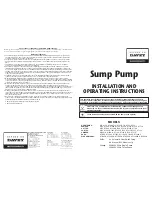
2 6 Refrigeration connections
"
This appliance uses refrigerant R410A
Comply with the legislation for handling refrigerants.
2 6 1 Rules and precautions
• After every intervention on the refrigeration circuit and
before final connection, take care to replace the plugs
in order to avoid any pollution from the refrigeration
circuit.
• Tools
-Set of manometers with hoses exclusively reserved
for HFCs (Hydrofluorocarbons).
-Vacuum pump specially for HFCs.
-Provision on using tools that have been in contact with
HCFCs (R22 for example) or CFCs.
-Use of a traditional vacuum pump is authorized if, and
only if, it is fitted with a non-return valve on the suction
side.
The manufacturer declines any liability with regard to the
guarantee if the above instructions are not observed.
• Flared connections
"
Lubrication with mineral oil (for R12, R22) is
forbidden
-Only lubricate with polyolester refrigeration oil (POE).
If POE is not available, fit without lubrication.
• Brazing on the refrigeration circuit (if necessary)
-Silver brazing (40% minimum recommended).
-Brazing only under dry nitrogen internal flux.
• To eliminate any filings in the pipes, use dry nitrogen
to avoid introducing any humidity that may adversely
affect the appliances operation. In general, take every
precaution to avoid humidity penetrating into the
appliance.
• Proceed to insulate the gas and liquid pipes to avoid
any condensation. Use insulating sleeves resistant to
temperatures over 120°C. In addition if the humidity
level in the areas where the refrigeration pipes pass
risks exceeding 70%, protect the pipes with insulating
sleeves. Use a sleeve thicker than 15mm if the humidity
reaches 80%, and a sleeve thicker than 20 mm
if the humidity exceeds 80%. If the recommended
thicknesses are not observed under the conditions
described above, condensation will form on the
surface of the insulation material. Lastly, take care to
use insulating sleeves whose thermal conductivity is
0.045 W/mK or less when the temperature is 20°C. The
insulation must be impermeable to resist the passage
of steam during the defrosting cycles (fibreglass wool
is prohibited).
2 6 2 Refrigeration connections
The outdoor unit must be connected to the hydraulic
unit with copper pipes and connections (refrigeration
quality), insulated separately.
Comply with the pipe diameters and the permitted pipe
lengths (
figure 17
).
The minimum length of the refrigeration connections
is 5 m for correct operation
.
The appliance will be excluded from guarantee if it is
used with refrigeration connections less than 5 m long.
Manipulate the pipes and take them through walls with
protective plugs in place.
If the distance between the outdoor unit and the
hydraulic unit exceeds the length of the maximum
conduits indicated in the table, an additional charge of
R410A must be loaded.
The quantity of R410A added must be adapted to the
length of the refrigeration circuit in order to the heat
pump’s performance without damaging the compressor
(See para. "Additionnal charge"
, page 20
).
Figure 16 - Prevention of gas leaks
Coat the flared surface
with
POE refrigeration oil
Do not use mineral oil
D
L
mini
5 m
Figure 17 - Pipe diameters (in inches) and permissible lengths (in meters)
Gas and liquid conduits
Gas
Liquid
Minimum
length (L)
*Maximum
length (L)
**Maxi level
difference (D)
Heat pump
Model
5/8"
3/8"
5
15
15
*
: Without additional charge of R410A.
**
: Taking into account the possible additional load of refrigerant R410A
(see
para. 2.7.3
,
page 20
).
Heat
pump
PAC
Installation and operating manual "1364 - EN"
Heat pump split single service 3 phase
- 16 -
















































